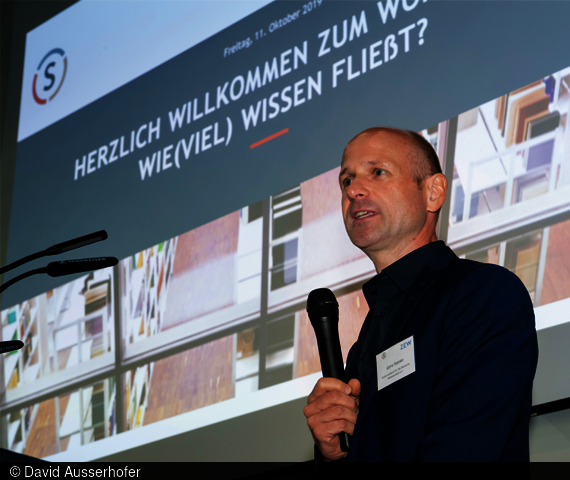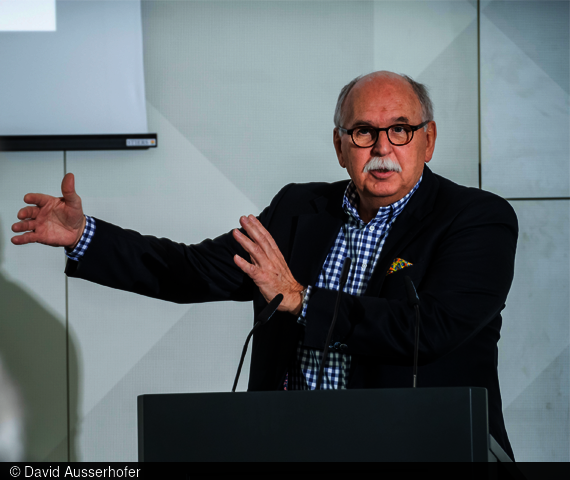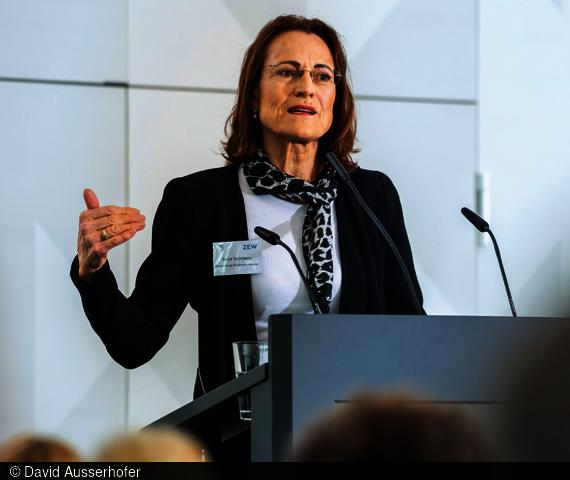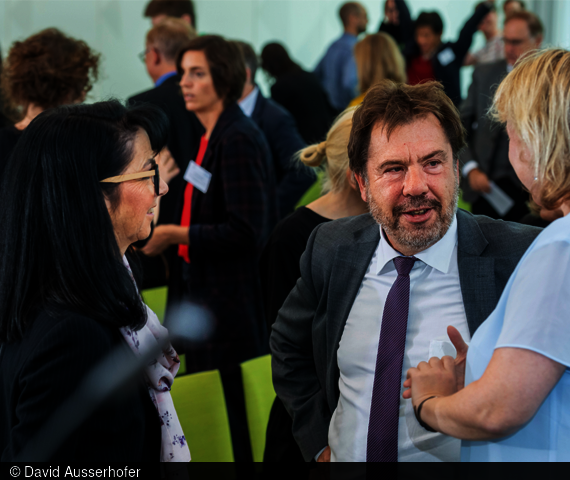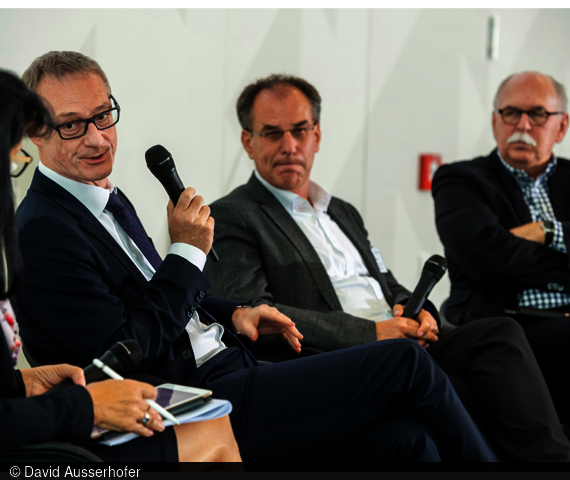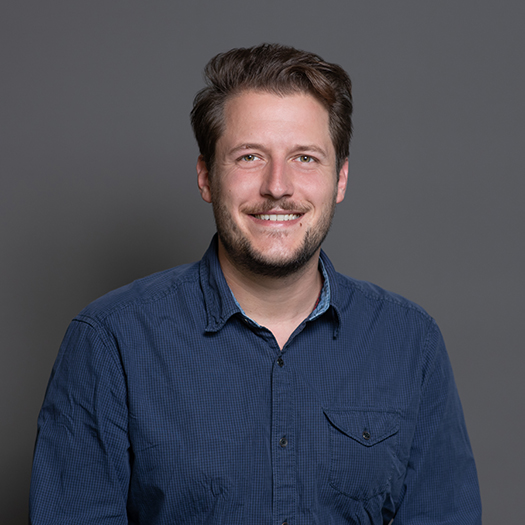The Flow of Knowledge
EventsConference on Knowledge Transfer Between Industry and Science
Strengthening the exchange of knowledge and technology between universities, public research institutes, and firms is a key policy priority in Germany. At the same time, indicators on the extent and content of transfer processes between the two sectors are largely missing. How to proceed on this challenge was at the centre of a conference that took place in Berlin on 11 October 2019. Jointly organised by ZEW Mannheim and Stifterverband and supported by the Federal Ministry of Education and Research, the event provided an opportunity for intensive exchange to its more than 130 participants. High-ranking representatives of companies, associations, research institutions, and from the world of politics delved into the details of technology and knowledge transfer.
In the first three panel sessions, experts presented the respective industrial and scientific views on topics like openness in innovation processes, knowledge transfer platforms, and the importance of cooperation between the two realms for the benefit of disruptive innovations. The fourth session focused on the evaluation of those findings from the perspective of innovation policy. The discussion, moderated by Professor Uschi Backes-Gellner from the University of Zurich, brought together four decision-makers from the realm of innovation policy: Professor Uwe Cantner, chair of the Commission of Experts for Research and Innovation, Dr. Stefan Kaufmann, member of the German Bundestag for the Christian Democrats, Professor Matthias Kleiner, president of the Leibniz Association, and State Secretary Christian Luft from the Federal Ministry of Education and Research.
Open innovation processes create added value
Opening up their innovation processes, companies aim to improve them by way of sharing their own knowledge and taking third-party players on board. Among other purposes, open innovation processes serve to obtain new impetus and ideas for products, to solve existing problems more efficiently and to drive technological development. However, there are manifold ways of implementing open innovation processes in practice. According to Kai Petrick, head of the department for Open Innovation at BMW, open innovation processes are crucial for BMW when it comes to generating new ideas unrelated to the company’s core business. To achieve this, the company pursues several strategies. BMW perceives itself as a “matchmaker”, bringing together internal and external experts, he said. Katharina Hochfeld, head of Corporate Culture and Transformation at Fraunhofer IAO, stressed that open innovation processes are also often used within companies – between, say, the various departments – in which case an open and transparent company culture is particularly important. Professor Torsten-Oliver Salge, co-director at RWTH Aachen’s Institute for Technology and Innovation Management then explained that open innovation processes are not always exclusively beneficial to companies. Rather, they can sometimes have negative side effects, such as the unwanted leaking of knowledge. This is why it is important to carefully gauge to what extent and under which conditions innovation processes are to be made transparent, he said. Dr. Ellen Enkel from Zeppelin University Friedrichshafen added that open innovation processes could be a particularly effective tool for established companies, as their reputation makes it easier to attract external partners. At the same time, she estimates that it is particularly new and smaller companies which can benefit the most from open innovation processes by gaining new expertise.
Knowledge transfer platforms – experiences shared
Knowledge transfer platforms seek to promote exchange between different companies as well as between companies and research institutions. Such platforms come in all shapes and sizes. By way of example, ZEW Research Associate Dr. Maikel Pellens, visiting lecturer at Ghent University in Belgium, cited international experiences with exchange services for intellectual property rights. Such exchange services create a market for trading intellectual property, particularly patents. Yet Pellens pointed out that current platforms are struggling with a variety of functional difficulties, the most severe one being the small number of traded patents. In his presentation, Professor Tom Brökel from the University of Stavanger, Norway, focused on the various kinds of proximity as contributing to the success of knowledge transfer processes. In particular, he identified geographical and technological proximity between the exchange partners as especially decisive factors. He furthermore argued that there is an optimal degree of technological proximity which allows the cooperating parties to benefit from one another’s knowledge while keeping at bay the costs for the players’ induction to their respective partners’ field of expertise. According to Brökel, this finding is particularly relevant to the promotion of joint projects for parties from significantly different technological fields, as it raises the question whether additional incentives for certain combinations of partners are economically worthwhile. On the other hand, geographical proximity, which might manifest itself as geographical clusters, for example, facilitates knowledge exchange between local players more generally. According to Professor Sonja Sackmann from the Bundeswehr University Munich, this factor has a key role to play in the initial personal contacts between the prospective partners, which, in turn, lay the foundations for long-term cooperation.
The right environment for disruptive innovation
Disruptive innovations fundamentally change existing markets. They replace previous products and services and have the potential to cause abrupt and fundamental renewals of long-standing, established systems. Dr. Ulrich Simon, head of Research & Technology at ZEISS group, illustrated this using the example of the camera industry. The latter was subjected to disruptive change twice within a single decade: First, analogue cameras were replaced by their digital successors, which were, in turn, ousted by smartphones. In both instances, the new products took over, by and large, the technological precursors’ market, Simon explained. The replacement of digital cameras with smartphones is a prime example of how disruptive innovations do not necessarily require technological progress, he added. In fact, other factors can play a decisive role, too. In this case, it was the emergence of social networks such as Facebook or Instagram. These platforms, which enable the exchange of pictures, were the main driver of the disruption, despite the fact that no major technological developments had revolutionised the field of camera technology. One of the challenges in analysing disruptive innovations lies in the ability to recognise them early on. All too often, this is only possible long after they first emerge. Dr. Georg Licht, a research department head at ZEW, suggested that new products be evaluated with respect to their market potential. As Ulrich Simon pointed out, companies are becoming increasingly aware of this necessity. Targeted support for disruptive innovations remains difficult, however. Professor Fabian Gässler from the Max Planck Institute for Innovation and Competition and TUM School of Management recommended that knowledge exchange between industrial and scientific partners should receive targeted support. This would assist companies in assessing the performance potential of new – potentially disruptive – technologies, many of which originate in research institutions. Agreeing with his colleague, Licht added that for disruptive innovations to thrive, it is necessary to create a generally fruitful environment, rather than only providing funding to individual innovation projects.
Panel discussion on assessment from an innovation policy point of view
The final panel discussion brought up new topics, but also dwelled on some of the issues raised previously. The discussion’s main themes were the significance of various types of information exchange between researchers and the private economy, as well as the evaluation of current and future support programmes. In addition, it was pointed out that fundamental research and knowledge transfer between researchers and the economy are not mutually exclusive, but both deserve to be promoted. Moreover, the panellists’ keynote speeches stressed the importance of translating innovation into products in order to ensure that the German economy remains fit for the future.
On the subject of evaluating support measures, Uwe Cantner underlined the need to find better ways of quantifying knowledge flows and carriers. Adding on to this, Christian Luft remarked that Germany requires the courage to terminate funding for projects if they do not deliver the desired output. Matthias Kleiner, president of the Leibniz Association, provided an example: Despite the generally very high level of quality among Leibniz institutes, time and again one of them is closed down as the result of evaluation processes in order to allow the best institutes to access the largest possible pool of resources.
Uschi Backes-Gellner explained that knowledge transfer strongly rests on personnel exchange. This was confirmed by Kleiner, who added that approximately 80 percent of PhD students go on to be employed by private companies. Joint professorships from universities and companies are another positive example. The discussion also showed, however, that there remains room for improvement. In particular, transitioning from private company to research institute employment and vice versa would benefit from more flexibility. Uwe Cantner furthermore pointed out that many universities now employ special knowledge transfer commissioners, while Stefan Kaufmann once again stressed the significant role that non-university-based research institutes play, particularly in combining applied research with basic research.
